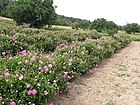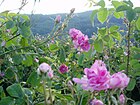Note: This is a project under development. The articles on this wiki are just being initiated and broadly incomplete. You can Help creating new pages.
Rosa damascena
Rosa x damascena is a deciduous shrub that can grow up to 1.50 metres tall. It is harvested from the wild for local use as a food, medicine and source of materials.
Uses
Parts Used
Chemical Composition
It contains β-citronellol (48.2 %), geraniol (17.0 %), β-phenylethyl benzoate (5.4 %) and phenyl ethyl alcohol (5.1 %) as the main components. The MIC values of oil were in the ranges of 0.125–1 μl/ml.[2]
Common names
| Language | Common name |
|---|---|
| Kannada | Gulabihuvu |
| Hindi | Gulab |
| Malayalam | Panniruppu |
| Tamil | Pannirpu |
| Telugu | Pannir roja |
| Marathi | Gulab |
| Gujarathi | |
| Punjabi | |
| Kashmiri | |
| Sanskrit | Atimanjula |
| English | Damask Rose |
.[3]
Properties
Reference: Dravya - Substance, Rasa - Taste, Guna - Qualities, Veerya - Potency, Vipaka - Post-digesion effect, Karma - Pharmacological activity, Prabhava - Therepeutics.
Dravya
Rasa
Guna
Veerya
Vipaka
Karma
Prabhava
Habit
Identification
Leaf
| Kind | Shape | Feature |
|---|---|---|
Flower
| Type | Size | Color and composition | Stamen | More information |
|---|---|---|---|---|
| {{{5}}} |
Fruit
| Type | Size | Mass | Appearance | Seeds | More information |
|---|---|---|---|---|---|
Other features
List of Ayurvedic medicine in which the herb is used
Where to get the saplings
Mode of Propagation
How to plant/cultivate
Succeeds in most soils, preferring a circumneutral soil and a sunny position. Grows well in heavy clay soils. Dislikes water-logged soils. The plant resists frost.[5]
Commonly seen growing in areas
[[:Category:Herbs that are commonly seen in the region of |]], [[:Category:Herbs that are commonly seen in the region of |]], [[:Category:Herbs that are commonly seen in the region of |]], [[:Category:Herbs that are commonly seen in the region of |]], [[:Category:Herbs that are commonly seen in the region of |]].
Photo Gallery
References
- ↑ Indian Medicinal Plants by C.P.Khare
- ↑ Chemical constituents
- ↑ Common names
- ↑ [Morphology]
- ↑ Cultivation
External Links
- Ayurvedic Herbs known to be helpful to treat Cold
- Ayurvedic Herbs known to be helpful to treat Cancer
- Herbs with Young leaves used in medicine
- Herbs with Petals used in medicine
- Herbs with Fruits used in medicine
- Herbs with Leaves used in medicine
- Herbs with common name in Kannada
- Herbs with common name in Hindi
- Herbs with common name in Malayalam
- Herbs with common name in Tamil
- Herbs with common name in Telugu
- Herbs with common name in Marathi
- Herbs with common name in Sanskrit
- Herbs with common name in English
- Habit - Deciduous shrub
- Index of Plants which can be propagated by Seeds
- Index of Plants which can be propagated by Cuttings of half-ripe wood
- Index of Plants which can be propagated by Cuttings of mature wood
- Index of Plants which can be propagated by Division of suckers
- Index of Plants which can be propagated by Air layering
- Herbs that are commonly seen in the region of
- Herbs






